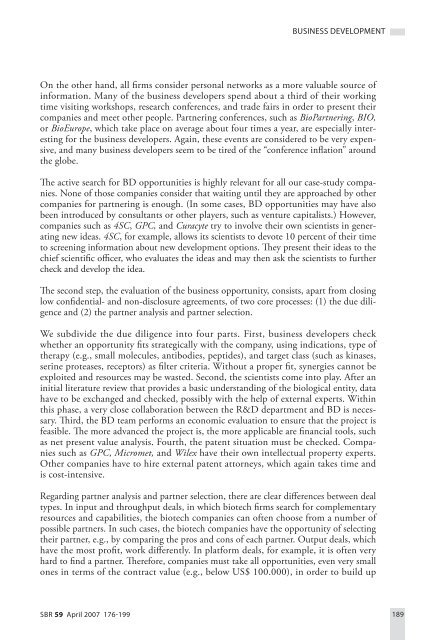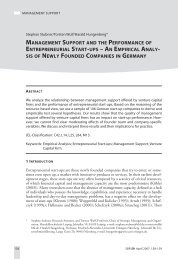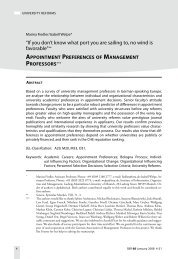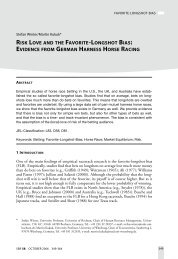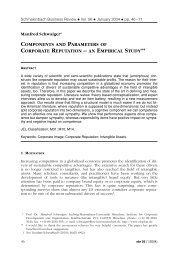“business development”? − the case of biotechnology - sbr ...
“business development”? − the case of biotechnology - sbr ...
“business development”? − the case of biotechnology - sbr ...
Create successful ePaper yourself
Turn your PDF publications into a flip-book with our unique Google optimized e-Paper software.
BUSINESS DEVELOPMENT<br />
On <strong>the</strong> o<strong>the</strong>r hand, all fi rms consider personal networks as a more valuable source <strong>of</strong><br />
information. Many <strong>of</strong> <strong>the</strong> business developers spend about a third <strong>of</strong> <strong>the</strong>ir working<br />
time visiting workshops, research conferences, and trade fairs in order to present <strong>the</strong>ir<br />
companies and meet o<strong>the</strong>r people. Partnering conferences, such as BioPartnering, BIO,<br />
or BioEurope, which take place on average about four times a year, are especially interesting<br />
for <strong>the</strong> business developers. Again, <strong>the</strong>se events are considered to be very expensive,<br />
and many business developers seem to be tired <strong>of</strong> <strong>the</strong> “conference infl ation” around<br />
<strong>the</strong> globe.<br />
Th e active search for BD opportunities is highly relevant for all our <strong>case</strong>-study companies.<br />
None <strong>of</strong> those companies consider that waiting until <strong>the</strong>y are approached by o<strong>the</strong>r<br />
companies for partnering is enough. (In some <strong>case</strong>s, BD opportunities may have also<br />
been introduced by consultants or o<strong>the</strong>r players, such as venture capitalists.) However,<br />
companies such as 4SC, GPC, and Curacyte try to involve <strong>the</strong>ir own scientists in generating<br />
new ideas. 4SC, for example, allows its scientists to devote 10 percent <strong>of</strong> <strong>the</strong>ir time<br />
to screening information about new development options. Th ey present <strong>the</strong>ir ideas to <strong>the</strong><br />
chief scientifi c <strong>of</strong>fi cer, who evaluates <strong>the</strong> ideas and may <strong>the</strong>n ask <strong>the</strong> scientists to fur<strong>the</strong>r<br />
check and develop <strong>the</strong> idea.<br />
Th e second step, <strong>the</strong> evaluation <strong>of</strong> <strong>the</strong> business opportunity, consists, apart from closing<br />
low confi dential- and non-disclosure agreements, <strong>of</strong> two core processes: (1) <strong>the</strong> due diligence<br />
and (2) <strong>the</strong> partner analysis and partner selection.<br />
We subdivide <strong>the</strong> due diligence into four parts. First, business developers check<br />
whe<strong>the</strong>r an opportunity fi ts strategically with <strong>the</strong> company, using indications, type <strong>of</strong><br />
<strong>the</strong>rapy (e.g., small molecules, antibodies, peptides), and target class (such as kinases,<br />
serine proteases, receptors) as fi lter criteria. Without a proper fi t, synergies cannot be<br />
exploited and resources may be wasted. Second, <strong>the</strong> scientists come into play. After an<br />
initial literature review that provides a basic understanding <strong>of</strong> <strong>the</strong> biological entity, data<br />
have to be exchanged and checked, possibly with <strong>the</strong> help <strong>of</strong> external experts. Within<br />
this phase, a very close collaboration between <strong>the</strong> R&D department and BD is necessary.<br />
Th ird, <strong>the</strong> BD team performs an economic evaluation to ensure that <strong>the</strong> project is<br />
feasible. Th e more advanced <strong>the</strong> project is, <strong>the</strong> more applicable are fi nancial tools, such<br />
as net present value analysis. Fourth, <strong>the</strong> patent situation must be checked. Companies<br />
such as GPC, Micromet, and Wilex have <strong>the</strong>ir own intellectual property experts.<br />
O<strong>the</strong>r companies have to hire external patent attorneys, which again takes time and<br />
is cost-intensive.<br />
Regarding partner analysis and partner selection, <strong>the</strong>re are clear diff erences between deal<br />
types. In input and throughput deals, in which biotech fi rms search for complementary<br />
resources and capabilities, <strong>the</strong> biotech companies can <strong>of</strong>ten choose from a number <strong>of</strong><br />
possible partners. In such <strong>case</strong>s, <strong>the</strong> biotech companies have <strong>the</strong> opportunity <strong>of</strong> selecting<br />
<strong>the</strong>ir partner, e.g., by comparing <strong>the</strong> pros and cons <strong>of</strong> each partner. Output deals, which<br />
have <strong>the</strong> most pr<strong>of</strong>i t, work diff erently. In platform deals, for example, it is <strong>of</strong>ten very<br />
hard to fi nd a partner. Th erefore, companies must take all opportunities, even very small<br />
ones in terms <strong>of</strong> <strong>the</strong> contract value (e.g., below US$ 100.000), in order to build up<br />
SBR 59 April 2007 176-199 189


